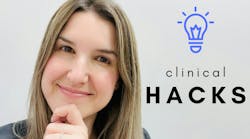As dental practitioners, we are always looking ahead to set ourselves up for success. Toward the end of the workday, we are typically consumed with tasks to ensure that the next clinical day will run smoothly. So how do you prepare? Does your task list include a chart audit? Do you have a checklist for the next day?
Why chart auditing is so important
The most important task should be auditing charts for the next day. With this done, there’s no room for error when a patient presents for treatment or as you verify that nothing was missed during scheduling. A comprehensive and well-done chart audit can magnify your production while simultaneously allowing you to provide exceptional therapy—all while not feeling burned-out or overworked that day.
The chart audit begins at the morning meeting
The best window to complete a chart audit is 24–48 hours before starting your day. You want to complete the audit well in advance to allow administration time for schedule changes that may be driven by insurance limitations or missed treatment plans. Most practices are familiar with the concept of a morning huddle or morning meeting. I like to call them the “morning pow-wow.”
Years ago, I worked at an office where my boss started the morning with gratitude and inspiration. That positivity in the first few words shared early in the morning set the tone for the rest of the day, leaving a twinkle of daily motivation in our team members.
Morning meetings allow the team to discuss any scheduling issues they may notice, ask questions about upcoming appointments and procedures, and possibly highlight patients who may require more care or time during their office visit. In some offices, this time is also used to discuss potential billings, production, and task delegation, such as lab work and daily ordering.
Having the team together early in the day encourages open communication with everyone present. It’s a time to dissect the schedule and highlight parts of the day that may require extra attention or adjustments. You can discuss each column, errors in booking, treatment options, consultations, and how to address and welcome new patients. This time gives the team a visual map of how the day will go.
Chart audits can increase productivity by reconfirming treatment options proposed to patients, allowing providers to preset trays, and limiting turnover time. We often don’t have time to read each patient’s chart thoroughly only minutes before they arrive. The morning meeting is the best time to note any medical conditions, personal requests, outstanding treatment, and past discussions that may need further consultation or education.
How block booking can help your schedule
Alongside chart audits, you want to maximize production time and schedule patients with variety and structure. Block booking can create a cohesive and structured schedule tailored to the practice and the practitioner’s production goal.
So, what is block booking? It’s a strategically implemented scheduling system customized to your work environment and client needs. Once this system is integrated into the practice, the entire team can collaborate, limiting the potential for error or unused production time. Block booking limits cancellations, office errors, and patient disappointment, creating a healthy and rewarding work environment that is sustainable every day and manageable for the staff.
Block booking allows the office to be in control of the schedule 100% of the time. Dental providers can create precalibrated schedules in their office software that keep appointments from being booked outside of working windows. This simultaneously limits incorrect booking while guiding the administrative team on the correct booking sequence and allotted time slots. Block booking will also help the team create templates with precalibrated times for different procedure types, regardless of provider type. The rule of thumb with block booking is to limit the amount of repetitive care each day, which elevates productivity.
To accommodate a variety of patients with different needs, create a daily schedule with these blocks:
- A block to accommodate NEW patients or COE updates
- A block to accommodate six-month recare patients
- A block to accommodate three-to-four-month periodontal maintenance patients
- A block to accommodate an SRP patient or prophy patients
- A block to accommodate a child/limited scale/digital scan
No more battling with the schedule
Block booking limits the chances of micromanaging the schedule or having to shuffle patients around. Pockets of time will be readily available for a new patient who calls to schedule an appointment or an SRP patient who requires another visit. Instead of battling with the schedule and not being able to accommodate patients on time, you’ll find block booking to be flexible and easy.
Everyone in the office should be able to access the block booking system and schedule patients, making it less of a stressor for the front desk. Being able to secure future time slots for patients adds a personal touch and allows providers to be in control of the time as they build relationships with clients.
Systems benefit the practice, and block booking is one of those systems. Implementing a new system may seem intimidating or hard to manage with the entire team, but early integration and acceptance of new systems can be rewarding (and seamless if done well). Consider giving the block booking system a shot, and discuss it with your office manager or practice owner.
Editor’s note: This article first appeared in Clinical Insights newsletter, a publication of the Endeavor Business Media Dental Group. Read more articles and subscribe.
Maryam Khan, BSc, RDH, is a registered dental hygienist in Toronto, Ontario, Canada. Maryam has more than 12 years of experience in dentistry. She is currently working as an educator with the hope of guiding the future of hygienists with the same passion she has for the profession. She believes in teamwork, career longevity, and patient satisfaction. Find Maryam on social media @hygienewithmaryam.








